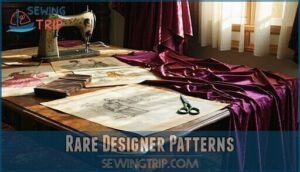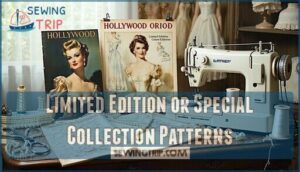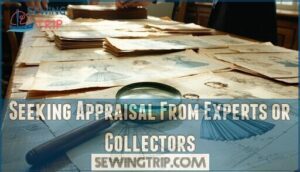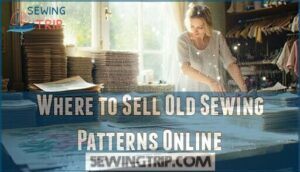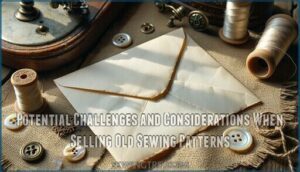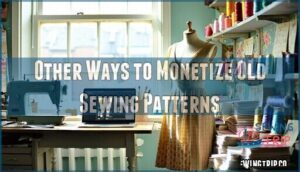This site is supported by our readers. We may earn a commission, at no cost to you, if you purchase through links.
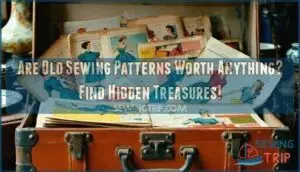 Yes, old sewing patterns can be worth significant money, especially vintage designer patterns from brands like Vogue, Butterick, or McCall’s.
Yes, old sewing patterns can be worth significant money, especially vintage designer patterns from brands like Vogue, Butterick, or McCall’s.
Rare patterns from the 1940s-1960s often sell for $20-200, while sought-after designer collaborations can fetch $300 or more.
Your pattern’s value depends on its age, rarity, condition, and whether it’s uncut with all pieces intact.
Designer names like Halston, Versace, or Issey Miyake boost worth considerably. Even common patterns gain value if they’re from popular eras or represent iconic styles.
The key lies in knowing which specific combinations of factors transform your grandmother’s old patterns into collector’s gold.
Table Of Contents
- Key Takeaways
- Factors That Determine The Value of Old Sewing Patterns
- Notable Examples of High-Value Vintage Sewing Pattern Sales
- How to Determine The Value of Your Old Sewing Patterns
- Where to Sell Old Sewing Patterns Online
- Tips for Maximizing The Value of Your Old Sewing Patterns
- Potential Challenges and Considerations When Selling Old Sewing Patterns
- Other Ways to Monetize Old Sewing Patterns
- Frequently Asked Questions (FAQs)
- Conclusion
Key Takeaways
- Designer patterns and rare pieces are where real money hides – You’ll find Vogue, Butterick, and McCall’s patterns from the 1940s-1960s selling for $20-200, with designer collaborations reaching $300+ at auction.
- Condition trumps everything else in determining value – You need uncut, factory-folded patterns with complete instruction sheets and pristine envelopes to command top dollar from serious collectors.
- Age and rarity create the perfect storm for high prices – You’re looking at patterns from the 1920s-1960s, especially limited production runs and mail-order designs that were affected by wartime restrictions.
- Multiple selling strategies can maximize your profits – You can sell individual pieces on eBay/Etsy, offer digitization services, create themed bundles, or collaborate with retro fashion brands for ongoing income streams.
Factors That Determine The Value of Old Sewing Patterns
If you’re wondering whether those old sewing patterns tucked away in your closet have any value, you’ll want to understand what makes some patterns worth a few dollars while others sell for hundreds.
Several key factors determine whether your vintage patterns are hidden treasures or just nostalgic keepsakes.
If you’re wondering whether those old sewing patterns tucked away in your closet have any value, you’ll want to understand what makes some patterns worth a few dollars while others sell for hundreds.
Several key factors determine whether your vintage patterns are hidden treasures or just nostalgic keepsakes.
Rarity and Scarcity
Scarcity drives sewing pattern value dramatically.
Limited production runs from the 1940s, especially mail-order patterns affected by wartime restrictions, command premium prices.
Regional availability and small print run sizes create today’s collector goldmines.
Pattern rarity determines worth—some rare 1940s designs have reached $2,025 at auction due to their extreme scarcity.
Some patterns are worth more than vintage cars—rarity creates collectors’ goldmines.
Similarly, market demand also substantially impacts value.
Designer or Brand
Designer names carry serious weight in vintage sewing patterns, with Vogue Patterns leading the pack.
You’ll find Couture Value skyrockets when notable labels like Vogue Paris Originals or Designer Influence from Oscar de la Renta appear on envelopes.
Brand Rarity becomes your goldmine—these designer labels can push sewing pattern prices from $25 to $400 for uncut examples, making vintage sewing patterns genuine treasures.
Condition and Completeness
Beyond surface-level inspection, you’ll discover that pattern condition determines whether you’re holding treasure or trash. Pattern completeness can make or break your sale—missing instruction sheets or cut pattern pieces slash values dramatically.
- Verify all pattern pieces match the envelope listing
- Check instruction sheets are intact and readable
- Examine for tears and stains that compromise pattern integrity
- Confirm factory folded status versus refolded condition
Pattern condition guide: Pristine, uncut patterns command premium prices, while damaged examples often sell in discount bundles.
Age and Era
In the context of pattern age, you’ll discover that older designs often command higher prices than their modern counterparts.
The most coveted patterns typically date from the 1920s through 1960s, with decade influence playing a major role in determining value.
Fashion evolution means earlier eras showcase unique silhouettes and construction techniques that today’s patterns simply don’t replicate.
Era popularity fluctuates with cultural trends—currently, 1950s patterns are experiencing renewed interest due to mid-century style revival.
Historical context matters too, as post-war 1940s designs represent innovation born from necessity.
Pattern dating becomes essential since even a few years can substantially impact worth within these golden decades of sewing pattern collectibility.
Demand and Popularity
When fashion trends shift, they create market fluctuation that directly impacts pattern demand.
Pattern demand swings with fashion cycles—what’s trending today becomes tomorrow’s treasure.
Media influence from shows like "Mad Men" sparked retro pattern popularity, driving up prices for 1960s designs.
Collector interests vary widely—some seek niche appeal items like vintage swimwear patterns, while others follow current fashion trends.
You’ll find that pattern popularity mirrors what’s trendy in stores today.
Market trends show that 1990s patterns are gaining value as that era’s styles return to mainstream fashion, which is a key factor in understanding pattern demand.
Notable Examples of High-Value Vintage Sewing Pattern Sales
You’ll discover that some vintage sewing patterns have sold for remarkable amounts, with the rarest examples reaching over $2,000 at auction.
These high-value sales typically involve pristine designer patterns from the 1920s through 1950s, proving that your grandmother’s pattern collection might contain genuine treasures.
Vintage Vogue Patterns
Vintage Vogue patterns represent the pinnacle of collectible sewing patterns, with certain pieces commanding extraordinary prices. These treasured finds showcase timeless elegance that collectors can’t resist pursuing.
The most valuable vintage Vogue patterns share three key collectibility factors:
- Vogue Eras from the 1920s-1950s – Early black and white envelope designs with signature red, white, and blue branding
- Designer Influence – Couturier Designs, Paris Originals, and collaborations with legendary names like Calvin Klein
- Rarity Levels – Factory-folded, uncut patterns with complete instructions and pristine envelopes
Pricing trends show most uncut vintage Vogue patterns selling for $20-$70, though exceptional pieces exceed $100. Collectors often look for patterns that are factory folded patterns, which are typically unused and in original condition. Pattern appraisal reveals that sewing pattern worth depends heavily on designer collaborations and era significance, making vintage sewing patterns from Vogue’s specialty lines particularly sought-after investments for serious collectors.
Rare Designer Patterns
Among fashion history’s most treasured finds, rare designer patterns by legends like Chanel, Dior, and Jacques Fath represent the ultimate collector’s prize.
These couture patterns showcase Designer Authenticity and Pattern Provenance that serious collectors crave. Designer Demand drives Investment Potential substantially higher than standard vintage sewing patterns.
Many collectors search for vintage Vogue patterns from iconic designers.
- Original 1950s Dior New Look patterns with complete construction details
- Authentic 1920s Madeleine Vionnet bias-cut dress designs
- Vintage Jacques Fath evening gown patterns from his couture collections
Collectible Designers’ rare pattern identification requires expertise, but fashion designers’ couture patterns offer unmatched historical value for dedicated collectors.
Limited Edition or Special Collection Patterns
Collectors treasure limited edition patterns like Hollywood Patterns and Designer Collaborations for their historical significance and rarity.
These special releases—including Starlet Covers from the 1930s-1940s and Bridal Patterns—command premium prices due to limited production runs.
Couture patterns featuring fashion designers can fetch $200-$462 at auction.
When major studios or renowned designers created exclusive patterns, they produced genuine collectibles that passionate sewists and vintage enthusiasts actively seek today.
How to Determine The Value of Your Old Sewing Patterns
You can determine your old sewing patterns’ value through careful research and expert assessment.
Start by comparing similar listings on eBay and Etsy, then consult specialized price guides or seek appraisals from experienced collectors who understand market trends.
Researching Similar Listings
Beyond guessing your pattern’s worth, you’ll need solid data from actual sales.
eBay price research through completed sales reveals what buyers actually paid, not wishful asking prices.
Etsy benchmarking shows current market trends, while auction insights help identify demand patterns.
Check both platforms for pattern pricing comparisons—focusing on similar condition, era, and designer attributes.
Market trends shift seasonally, so recent sewing pattern values matter more than old listings.
Pattern appraisal becomes accurate when you compare your items against documented pattern resale value data from multiple sources, using pattern resale value.
Consulting Price Guides and Reference Books
Price guides offer thorough market analysis for antique patterns value, featuring detailed charts with historical data and current sewing pattern values.
These specialized references help you identify pattern pricing through provenance research, comparing your items against documented sales.
Expert appraisals within these guides provide pattern resale value benchmarks, though you’ll need recent marketplace data to supplement their findings for complete Guide Accuracy, ensuring you have the most up-to-date information for antique patterns.
Seeking Appraisal From Experts or Collectors
When reference books don’t provide enough insight, professional Expert Appraisers and Collector Networks offer specialized knowledge about antique patterns value.
These Authentication Services examine design details, rarity, and provenance to determine collectible sewing patterns worth.
While Appraisal Costs vary, specialists help identify valuable pieces you might overlook.
Their expertise proves invaluable when Negotiating Offers, as they understand the vintage pattern market’s nuances and can guide your old pattern appraisal decisions.
Where to Sell Old Sewing Patterns Online
Once you’ve determined your patterns’ value, you’ll need to choose the right online platforms to reach serious collectors and sewists.
Popular options include specialized vintage websites like Etsy and eBay, along with dedicated sewing communities where enthusiasts actively search for specific patterns.
Vintage and Collectible Websites
Vintage collectible websites offer dedicated marketplaces where serious collectors browse for rare finds.
eBay and Etsy dominate online marketplaces, hosting thousands of vintage sewing patterns with robust seller reputation systems and secure payment security.
Platform fees typically range 5-7%, while website functionality includes detailed search filters for collectible sewing patterns.
These specialized platforms provide extensive shipping options, connecting you with buyers who understand pattern value and pay premium prices accordingly.
Sewing and Craft Forums and Groups
Sewing communities serve as treasure troves for pattern collectors seeking rare finds. These online communities offer Pattern Identification help, Project Showcases featuring vintage creations, and Technique Sharing among enthusiasts.
You’ll discover Resource Discovery opportunities and Community Events through dedicated sewing forums.
- Join vintage pattern forums for expert advice on identifying valuable designers and rare editions
- Participate in sewing pattern collecting forums to learn market trends and pricing strategies
- Share Project Showcases using vintage patterns to build relationships with potential buyers
- Access Resource Discovery through experienced collectors who know where to find specific patterns
- Attend Community Events organized by online communities for face-to-face trading opportunities
Tips for Maximizing The Value of Your Old Sewing Patterns
You can maximize your patterns’ value by implementing a few strategic techniques that collectors and buyers actively seek.
Proper storage, detailed descriptions, quality photos, and smart bundling strategies will help you command top dollar for your vintage sewing treasures.
These techniques, including proper storage, are essential to maintaining the value of your items.
Properly Storing and Preserving Patterns
Your vintage sewing patterns are like delicate heirlooms that need proper care to maintain their value. Start with acid-free storage solutions—archival sleeves or folders protect against chemical breakdown that destroys paper over time.
Store patterns flat in a cool, dry location with humidity control between 30-50% to prevent warping and mold growth. You can find specialized options for archival storage products online.
Pest prevention matters more than you’d think. Moths and silverfish love munching on old paper, so consider cedar blocks or lavender sachets as natural deterrents. When handling patterns, use clean, dry hands and avoid folding along original creases repeatedly—this weakens the tissue paper.
For pattern preservation, keep them away from direct sunlight and heat sources. If you notice small tears, gentle repairing damage with archival tape maintains pattern condition better than ignoring problems.
Proper sewing pattern storage and sewing pattern preservation techniques can substantially boost resale value, transforming fragile tissues into marketable treasures.
Providing Detailed and Accurate Descriptions
The secret to commanding top dollar lies in crafting pattern descriptions that read like treasure maps for collectors.
Include Era Details such as "1950s" or "early 1960s," along with specific brand names like "Vogue Paris Original" or "McCall’s."
Your product descriptions should feature Accurate Measurements, Fabric Recommendations, and any Noted Flaws like missing pieces or tears.
Mention the required Sewing Skill level, from beginner to advanced couture techniques.
A thorough condition assessment transforms browsers into buyers—they’ll know exactly what they’re getting.
Smart product details separate serious sellers from amateur declutterers, helping collectors make informed decisions and boosting your credibility in the vintage pattern marketplace.
Including Clear and Attractive Photos
Professional photographs sell vintage sewing patterns faster than amateur snapshots.
Use natural lighting near windows for crisp detail shots showing pattern pieces, envelope artwork, and instruction sheets.
Good image composition includes multiple angles – front, back, and close-ups of any damage or unique features.
Simple staging ideas like neutral backgrounds help patterns stand out, and basic editing software can enhance brightness and contrast for clearer pattern photography that highlights condition accurately, using techniques such as adjusting brightness and contrast.
Offering Bundles or Sets for Added Value
Beyond individual listings, strategic pattern bundles can substantially boost your buyer appeal and profits. Smart bundle pricing creates irresistible deals that showcase your curating expertise while offering storage savings for collectors.
Consider these winning pattern themes for your vintage sewing patterns:
- Era-specific collections – Group 1940s day dresses or 1960s mod styles
- Designer showcases – Bundle Vogue Couturier or McCall’s designer series
- Garment type sets – Combine evening wear or children’s patterns
- Size-coordinated lots – Match patterns for similar measurements
- Seasonal themes – Create holiday or summer wardrobe bundles
When selling old patterns, experiment with lot size to find your sweet spot. Understanding fabric drape properties is also vital for indicating the best material to use with the pattern. Sewing pattern collecting enthusiasts often prefer themed bundles over random assortments, making your curated collections more valuable than individual pieces.
Potential Challenges and Considerations When Selling Old Sewing Patterns
While selling vintage patterns can be profitable, you’ll face several practical hurdles that require careful planning.
Copyright concerns, fragile paper conditions, and proper shipping methods can substantially impact your success and bottom line.
Copyright and Intellectual Property Issues
Traversing pattern copyright laws can trip up even seasoned sellers. Understanding pattern intellectual property protects you from legal headaches while maximizing profits.
| Copyright Status | Selling Rights |
|---|---|
| Pre-1923 patterns | Public domain – fully sellable |
| 1923-1963 unregistered | Likely public domain |
| Post-1978 patterns | Protected 95+ years |
| Designer Attribution required | Check licensing agreements |
| Expired Copyrights confirmed | Safe for pattern reproduction rights |
Original vintage patterns are generally safe to resell, but digital pattern piracy through unauthorized copying remains illegal. You can often find free downloadable patterns on various websites.
Research each pattern’s copyright status before reproducing or creating digital copies to avoid pattern resale legality issues.
Condition of Patterns and Instructions
Pattern condition directly impacts your selling potential, but don’t let imperfections discourage you completely.
When conducting a pattern condition check, examine each piece for tears and stains that might affect usability.
While completeness matters substantially, missing instruction sheets don’t automatically render vintage sewing patterns worthless.
Factory folded patterns command premium prices, but even refolded ones retain value if rare.
During your pattern condition evaluation, consider restoration feasibility—minor tears can often be repaired with archival tape, and missing pieces might be recreated by experienced sewers.
Some collectors actually prefer patterns showing gentle use over pristine examples, viewing them as authentic pieces of fashion history.
The key lies in understanding your audience.
Pattern rarity value often trumps condition concerns among serious collectors.
A 1940s Vogue Couturier Design with slight damage will still attract buyers who recognize its historical significance.
Focus your pattern rarity research on designer labels and unusual sizes, as these factors can offset condition issues and maintain strong market appeal.
Packaging and Shipping Methods
Smart pattern shipping protects your investment and keeps customers happy. Beyond careful condition assessment, you’ll need proper packaging techniques and shipping strategies to maintain your pattern’s value during transit.
Your shipping success depends on three key elements:
- Protective materials like acid-free tissue paper, rigid mailers, and bubble wrap prevent creases and tears
- Shipping insurance and package tracking provide peace of mind for high-value pattern listings worth over $50
- Cost optimization through calculated shipping rates helps maximize your pattern monetization profits
Clear customer communication about your pattern packaging methods builds trust in your online selling reputation. Using archival quality materials is key to long-term preservation. Professional shipping practices distinguish serious sellers from casual hobbyists in the vintage pattern marketplace.
Other Ways to Monetize Old Sewing Patterns
You don’t have to stop at simply selling your old patterns for a one-time profit.
There are creative ways to transform your vintage collection into ongoing income streams that capitalize on the growing interest in retro fashion and sustainable sewing practices.
Creating Reproduction Patterns
From vintage sewing patterns to modern treasures, creating reproduction patterns opens up exciting income possibilities. You’ll transform delicate originals into sellable copies while preserving fashion history.
Start the digitalization process by taking high-resolution scans of pattern pieces. Confirm copyright compliance before reproducing any designs—some patterns remain protected. Focus on scaling reproductions accurately, maintaining original proportions and seam allowances. Modern adaptations might include updated sizing charts and clearer instructions for today’s sewists. One can even use online pattern design software to aid in this process.
The accuracy challenges you’ll face include deciphering faded markings and reconstructing damaged pieces. However, pattern reproduction rewards patience with multiple sales from one original. Consider these vivid scenarios:
- Scanning a 1950s cocktail dress pattern while your grandmother’s sewing box sits nearby
- Testing your reproduction on fabric scraps, ensuring perfect fit
- Watching customers recreate vintage glamour from your digital patterns
- Building a library of historically accurate sewing pattern reproduction files
This approach lets you monetize vintage sewing patterns without selling irreplaceable originals. Pattern digitization preserves crafting heritage while generating ongoing revenue streams. By following this method, you can create a valuable resource for sewists while also preserving the history of fashion and textile design.
Offering Pattern Digitization Services
Digital transformation opens new revenue streams for pattern owners.
You can offer sewing pattern digitization services to preserve vintage designs while earning income.
Modern sewers desperately need digital versions of out-of-print patterns, creating strong market demand for pattern scanning services.
Your digitization benefits include reaching global customers and creating passive income streams.
Service pricing typically ranges from $15-50 per pattern, depending on complexity and restoration techniques required.
You can find a pattern digitization service online.
Popular file formats include PDF, SVG, and DXF for different sewing software compatibility.
Copyright concerns require careful navigation—focus on public domain patterns or obtain proper permissions.
Pattern restoration involves cleaning damaged areas, enhancing faded lines, and ensuring accurate measurements.
Many collectors pay premium prices for professionally scanned vintage patterns that maintain original proportions and details, which can lead to strong market demand and increased revenue for pattern owners.
Collaborating With Fashion Designers or Retro Clothing Brands
Beyond the sewing machine, fashion designers and retro clothing brands actively seek authentic vintage sewing patterns for their collections.
These Designer Collaborations create Brand Partnerships where your patterns become valuable assets worth licensing fees or profit-sharing agreements.
- Licensing Patterns to established brands generates ongoing royalties from reproduced designs
- Fashion collaborations with indie designers offer creative recognition and networking opportunities
- Pattern partnerships with vintage-inspired companies provide steady income streams from your collection
- Modern Interpretations of classic designs showcase your patterns’ Retro Influence in contemporary fashion
Frequently Asked Questions (FAQs)
How do you determine the value of Vintage sewing patterns?
Check condition (uncut patterns with intact envelopes are most valuable), research designer/brand (Vogue, Couturier designs command higher prices).
Assess rarity and age (1920s-1940s patterns worth most).
Then compare similar sales on eBay/Etsy for pricing.
Are Vintage sewing patterns worth collecting?
Collecting vintage sewing patterns is like striking gold in dusty attics – you’ll find treasures worth real money.
Rare designer patterns from the 1940s-1950s can fetch $25-$400, with some reaching $2,025 at auction, making them worthwhile investments.
Can old sewing patterns be sold?
You can absolutely sell old sewing patterns.
Online platforms like eBay and Etsy offer excellent marketplaces, while vintage fairs provide face-to-face opportunities.
Success depends on proper research, quality photos, and detailed descriptions highlighting condition and designer details.
Are old sewing patterns worth a penny?
Like treasure hunting through dusty attics, you’ll discover most old sewing patterns aren’t worth much—typically just a few dollars.
But rare designer pieces from the 1920s-1940s can fetch hundreds.
How do you know if a Vintage sewing pattern is old?
You’ll identify vintage sewing patterns by examining the envelope’s design, typography, and printing style.
Look for older company logos, date stamps, or copyright years.
Fashion illustrations and pattern numbers also reveal age – earlier decades used different numbering systems, which can help in identifying the vintage sewing patterns.
Is there a market for old patterns?
Yes, there’s a strong market for vintage sewing patterns. You’ll find active buyers on eBay, Etsy, and vintage fairs seeking rare designer patterns, especially from the 1920s-1960s era.
How can you tell how old a sewing pattern is?
Check the copyright date on the pattern envelope—it’s usually printed near the pattern company’s name.
You’ll also find clues in the fashion style, envelope design, and pricing, which reflect different decades’ trends and inflation.
Are sewing patterns valuable?
Vintage patterns are hidden treasures in dusty boxes—some worthless, others worth hundreds.
Most sell for under $25, but rare 1920s-1940s designer patterns can fetch $200-$
Condition and completeness determine value.
How much do vintage patterns cost to ship?
Shipping costs typically range from $3-8 for domestic mail, depending on envelope size and weight. You’ll pay more for tracking, priority mail, or international shipping, which can reach $15-
Whats the typical profit margin on pattern sales?
Your profit margin typically ranges from 200-500% when you buy patterns for $1-3 and sell them for $5-25, though rare designer pieces can yield even higher returns.
Conclusion
Don’t count your chickens before they hatch when evaluating whether old sewing patterns are worth anything.
Your collection might contain genuine treasures hiding in plain sight.
Designer patterns, rare editions, and well-preserved vintage pieces can command impressive prices among collectors and sewing enthusiasts.
The key lies in understanding what makes patterns valuable and taking time to research your specific items.
With proper evaluation, storage, and marketing, those dusty patterns could transform into unexpected profit while preserving sewing history for future generations.
- https://www.lovetoknow.com/home/antiques-collectibles/vogue-patterns
- https://www.antique-hq.com/guide-to-collecting-vintage-sewing-patterns-3636/
- https://mellysews.com/most-expensive-sewing-patterns/
- https://community.etsy.com/t5/Vintage-Sewing-Pattern-Sellers/Pricing-patterns/td-p/23350887
- https://www.youtube.com/watch?v=1bCyHvQf1kA


